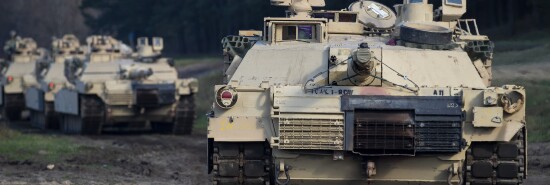
100 tanks will go a long way for Ukraine, figuratively and literally
Tom Rogan
Correcting weeks of hesitating delay and deceptive excuses, President Joe Biden announced Wednesday that the United States would provide 31 M1A2 Abrams tanks to Ukraine. He noted that this would allow Ukraine to form a new armored battalion. Alongside the 12 Challenger-2 tanks that the United Kingdom has already pledged to provide Ukraine, Biden said Europe would supply Ukraine with an additional two battalions worth of Leopard-2 tanks. In total, Ukraine is set to receive just over 100 of the most modern Western battle tanks. The first Leopard-2 tanks should have trained crews within eight weeks. Unfortunately, Germany says it will take at least three months for the first tanks to be delivered.
These tanks will afford Ukrainian forces with significant new tactical flexibility.
UKRAINE ANTI-CORRUPTION PUSH: POSITIVE, BUT MIDRANKING OFFICIALS MUST ALSO BE TARGETED
First, the tanks will allow Ukraine to conduct combined arms offensives against hardened Russian defensive lines. Since the start of this year, Ukraine has primarily focused on a static defensive effort against Russian forces in eastern, southern, and southeastern Ukraine. As a result, Ukrainian forces have taken heavy casualties around areas such as the southeastern town of Soledar. Still, Ukraine has kept much of its mechanized, artillery, and armored infantry forces in reserve. Kyiv’s intent: Make Russian forces pay dearly and expend finite artillery, drone, and other resources for territorial gains of limited strategic value.
Adding tanks to the forces Ukraine has kept in reserve gives Kyiv the means to conduct a major offensive. Russian anti-armor forces are woefully underarmed and undermanned to counter Western battle tanks adequately. Russian tactical air support is of equally limited utility. This bears particular note in relation to a prospective Ukrainian offensive across the Dnieper River to sever Russia’s land bridge to Crimea. An action for which the Ukrainians already appear to be preparing the battlefield.
As I noted last November, both sides understand the decisive quality attached to such an offensive. If successful, this action will dislocate Russian forces at scale, making Moscow choose between massive surrenders, force annihilation, or escalation (such as via nuclear weapons). This dislocation would also feasibly allow Ukraine to achieve key strategic objectives without necessitating a direct offensive into Crimea. An action that might well precipitate Russian nuclear escalation.
Contrary to U.S. claims, however, that Washington is leading the push for Ukraine to conduct such an offensive, the U.K. has been the primary voice for Ukrainian counteroffensives. Evinced by the hesitation that has defined the U.S. provision of weapons to Ukraine and the countermanding example of U.K. special forces activities, the U.S. has traditionally adopted a more risk-averse stance in Ukraine. These tanks may signify greater boldness on Biden’s part.
Alternatively or additionally, the tanks will allow Ukraine to conduct more limited offensives centered on lightning runs behind Russian lines. The gross inadequacy of most Russian forces’ command and control, organization, logistics, morale, and training means that Ukrainian armored attacks are likely to provoke widespread and disorganized retreats. Or, at a minimum, chaos. Such chaos will open gaps for Ukrainian mechanized and dismounted forces to advance and retake territory.
The final opportunity that these tanks provide is a political one. With a multinational coalition now providing tanks to Ukraine, Russia must consider that its effort to divide the West and weaken its resolve is failing. This will have a further demoralizing impact on the Kremlin and Russian commanders. It will directly increase pressure on Russian President Vladimir Putin, who must now expect new setbacks in a conflict that was supposed to be won in days but has required vast costs.
Put another way, Russia has a problem.
CLICK HERE TO READ MORE FROM THE WASHINGTON EXAMINER
